
Coastal Management
Global Challenges and Innovations
- 546 pages
- English
- ePUB (mobile friendly)
- Available on iOS & Android
Coastal Management
Global Challenges and Innovations
About this book
Coastal Management: Global Challenges and Innovations focuses on the resulting problems faced by coastal areas in developing countries with a goal of helping create updated management and tactical approaches for researchers, field practitioners, planners and policymakers. This book gathers, compiles and interprets recent developments, starting from paleo-coastal climatic conditions, to current climatic conditions that influence coastal resources. Chapters included cover almost all aspects of coastal area management, including sustainability, coastal communities, hazards, ocean currents and environmental monitoring.- Contains contributions from a global pool of authors with a wide range of backgrounds and disciplines, making this an authoritative and compelling reference- Presents the appropriate tools used in monitoring and controlling coastal management, including innovative approaches towards community participation and the implementation of bottom-up tactics- Includes case studies from across the world, allowing for a thorough comparison of situations in both developing and developed countries
Frequently asked questions
- Essential is ideal for learners and professionals who enjoy exploring a wide range of subjects. Access the Essential Library with 800,000+ trusted titles and best-sellers across business, personal growth, and the humanities. Includes unlimited reading time and Standard Read Aloud voice.
- Complete: Perfect for advanced learners and researchers needing full, unrestricted access. Unlock 1.4M+ books across hundreds of subjects, including academic and specialized titles. The Complete Plan also includes advanced features like Premium Read Aloud and Research Assistant.
Please note we cannot support devices running on iOS 13 and Android 7 or earlier. Learn more about using the app.
Information
Global Coasts in the Face of Disasters
Abstract
Keywords
1 Introduction
2 Global Framework and Coast
3 Disaster Risk and Coasts
4 Way Forward
☆Special Coastal Management Area Concept Experience in Sri Lanka
† Department of Geography, University of Peradeniya, Peradeniya, Sri Lanka
Abstract
Keywords
Table of contents
- Cover image
- Title page
- Table of Contents
- Copyright
- Contributors
- Editors Bio
- Foreword
- Editorial Note
- Chapter 1: Global Coasts in the Face of Disasters
- Chapter 2: Special Coastal Management Area Concept Experience in Sri Lanka
- Chapter 3: Coastal Development: Construction of a Public Policy for the Shores and Seas of Mexico
- Chapter 4: Governance of the Nautical Sector on the Coasts of Bahias de Huatulco in Oaxaca, Mexico
- Chapter 5: Sustainable Coastal Management for Social-Ecological Systems—A Typology Approach in Indonesia
- Chapter 6: Evaluation and Management Strategies of Tourist Beaches in the Pacific Coast: A Case Study From Acapulco and Huatulco, Mexico
- Chapter 7: Evaluation of Decadal Shoreline Changes in the Coastal Region of Miri, Sarawak, Malaysia
- Chapter 8: A View on South Africa's KwaZulu-Natal Coast: Stressors and Coastal Management
- Chapter 9: Integral Management of the Coastal Zone to Solve the Problems of Erosion in Las Glorias Beach, Guasave, Sinaloa, Mexico
- Chapter 10: An Innovative Technique of Tidal River Sediment Management to Solve the Waterlogging Problem in Southwestern Bangladesh
- Chapter 11: Coastal and Marine Biodiversity of India: Challenges for Conservation
- Chapter 12: Implication and Management of Coastal Salinity for Sustainable Community Livelihood: Case Study From the Indian Sundarban Delta
- Chapter 13: Fostering Climate Change Mitigation Through a Community-Based Approach: Carbon Stock Potential of Community-Managed Mangroves in the Philippines
- Chapter 14: Importance of Seagrass Management for Effective Mitigation of Climate Change
- Chapter 15: Managing Mangrove Forests Using Open Source-Based WebGIS
- Chapter 16: Ecological Studies in the Coastal Waters of Kalpakkam, East Coast of India, Bay of Bengal
- Chapter 17: Management of Coastal Groundwater Resources
- Chapter 18: Practices of Tsunami Evacuation Planning in Padang, Indonesia
- Chapter 19: Numerical Analysis of Changes in Ocean Currents and Density Structures in Miyako Bay, Japan, Before and After the Great East Japan Earthquake
- Chapter 20: Assessment of Potential Oil Spill Risk Along Vishakhaptnam Coast, India: Integrated Approach for Coastal Management
- Chapter 21: Using Low-Cost UAVs for Environmental Monitoring, Mapping, and Modelling: Examples From the Coastal Zone
- The Way Forward
- Index